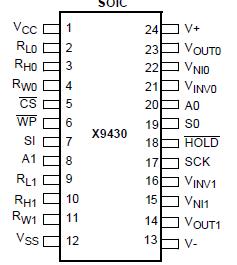X9430: Features: • Two CMOS voltage operational amplifiers• Two digitally controlled potentiometers• Can be combined or used separately• Amplifiers-Low voltage operation-V+/V- = ±2....
floor Price/Ceiling Price
- Part Number:
- X9430
- Supply Ability:
- 5000
Price Break
- Qty
- 1~5000
- Unit Price
- Negotiable
- Processing time
- 15 Days
SeekIC Buyer Protection PLUS - newly updated for 2013!
- Escrow Protection.
- Guaranteed refunds.
- Secure payments.
- Learn more >>
Month Sales
268 Transactions
Payment Methods
All payment methods are secure and covered by SeekIC Buyer Protection PLUS.

 X9430 Data Sheet
X9430 Data Sheet








